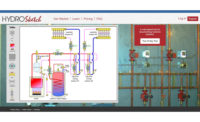Created in 1957, the single stack Sovent system works by utilizing two unique fittings: aerators and deaerators (see drawing). All other pipe and fittings and connections to these fittings are standard and consistent with conventional DWV systems. The Sovent system is vented through the roof and is open to the atmosphere. There are fixture unit values and sizing requirements along with rules to adhere to. The criteria can be found at www.sovent.com.
Basic Design & Operation. The Sovent system allows the drain, waste and venting to be accomplished through a single stack. The aerator fittings, which are located in the vertical stack, have three outlets to serve various fixture branch connections. The aerator also has a double inline offset configuration, which performs as a vertical velocity break and controls the vertical flow of the waste and water that is discharged into the Sovent system.
Aerator fittings are required within 20-foot intervals so that there is a sufficient column of air within the vertical pipe. At approximately 33 feet, terminal velocity is reached and the falling waste and water can create a “plug” formation, which would cause both a positive and negative pressure problem, jeopardizing trap seals. The positive and negative pressures in a Sovent system are controlled and will not exceed +/- 1-inch water column, which is the accepted standard in all national plumbing codes.
The deaerator fitting is used at the base of a Sovent stack or at a horizontal offset that exceeds 60 degrees. The purpose of the deaerator fitting is to re-direct positive pressure when changing direction from vertical to horizontal piping. The positive pressure, which is a result of “hydraulic jump,” is forced to occur in the deaerator at the nose piece part of the fitting before the actual change of direction of the piping.
The positive pressure is re-directed from the deaerator fitting into a pressure relief line (PRL) upstream of the sweep. After the change of direction occurs inside the deaerator, the velocity of the waste and water are slowed and allow for a controlled flow into the horizontal piping. The PRL is connected back to the horizontal piping a minimum distance downstream. The positive and negative pressures are controlled at this change of direction so the fixture trap seals are protected where they connect to the horizontal piping.
There are rules for fixture branches with respect to maximum developed lengths and pipe sizes. Proper flow is dependant upon the ratio of air and water in the pipe. Flowing downstream, the pipe size increases so there is always 75% of the waste pipe dedicated to air and 25% for water. This ratio assures that there will be proper flow.

Drawing 1.
Plumbing Engineer Benefits
Easier and faster to design. Because the Sovent system needs much less pipe and fittings, there is less to draw and review. This allows designs to be completed quicker. Because there is one stack and no additional vents, plumbing designers do not have as many coordination issues in walls or drop ceiling spaces. There is additional space to allow for other needs.
Easier and less expensive to modify for tenant changes. Because there are no additional vents needed with the Sovent, tenant changes are less invasive to the existing structure.
Contributes to budgeting. Too often, projects are over budget. Sovent is cost effective and the plumbing engineer can incorporate the design of the system up front into the project for the owners’ benefit.
Reliable performance. Extensive testing and more than 50 years of performance in the field have made Sovent a proven DWV system. The goal is to remove waste and water in plumbing fixtures from the building and protect trap seals. The system accomplishes this in a most efficient and cost-effective manner.
Qualifies for a LEED credit. Sovent can qualify for a LEED credit under the innovative systems section of LEED criteria.
Plumbing Contractor Benefits
Uses less pipe and fittings and related labor. With a single vertical stack, the Sovent eliminates a separate vent stack and an intermediate vent. This saves, on average, 50% of the pipe and a higher relative percent of fittings, hangers, riser clamps and joints to connect. With less materials needed, storage space and shipping costs are reduced.
Reduces the number of penetrations. Penetrations through floors in a multi-story building are “fire-rated” and more costly than non-rated penetrations. With this system, the penetrations for the vent stack and intermediate vents are eliminated and laying them out is reduced.
Requires less fire-rated materials. If the wall that the Sovent stack is located in is fire-rated, then the amount of fire-rated materials is reduced. There are no other vents required in a Sovent system so the problem of coordinating with other trades is minimized. Many vents for typical bathrooms end up in drop ceiling spaces that usually have a variety of trades trying to accommodate their materials and equipment, which results in conflicts that add to the cost of the project. Eliminating overhead vents also reduces the greatest cost related to installing DWV piping: the hanging overhead piping.
Saves labor time and water during testing. There is approximately 50% less pipe to test, along with less water needed (and wasted) to fill and drain the system. Plus, the number of potential leaks are reduced because the number of joints is reduced. And there are fewer test plugs to put in and take out.
Promotes fast-track scheduling. Minimizing coordination delays and installing and testing the Sovent system faster than conventional systems contributes to the plumbing contractor keeping up with the pace of the project.
Simplifies the installation of a DWV system. Because Sovent uses a single stack without other vents, the installation and the inspection process is simplified. In contrast, conventional DWV systems can be more complicated, particularly when jobs are constructed in various jurisdictions. Rules on conventional venting vary from jurisdiction to jurisdiction.
Common questions related to Sovent
How many stories must a job be before Sovent is cost effective? The cost effectiveness is dependant more on the plumbing layout, not the number of stories. A two-story project can potentially be a good Sovent job.
Can you have a sudsing problem with Sovent? Soap suds are a potential plumbing problem in any DWV system. It is recommended to isolate clothes washers from other fixtures.
Where should cleanouts be located? Local codes address cleanouts and it is recommended they be located at the base of the Sovent stack.
How do we clean the system? It is recommended to clean the vertical stack from the vertical stack and clean fixture branches from fixture branches.
Aren’t some of the Sovent traps S-Traps? The difference with an S-Trap and traps that may appear to look like an S-Trap is that the pipe size is increased as the transition is made from a trap arm to the waste arm. This increase in size allows more air in the pipe relative to the amount of water, and this is why it is not an S-Trap.
Do we need bigger walls for Sovent? No, a Sovent system fits into the same size wall as a conventional two-pipe system. A 4-inch aerator and deaerator fit in a 6-inch wall.
To read the "Counterpoint" perspective of this month’s Point/Counterpoint article on Single-Stack Systems for High-Rise Buildings, click here.


